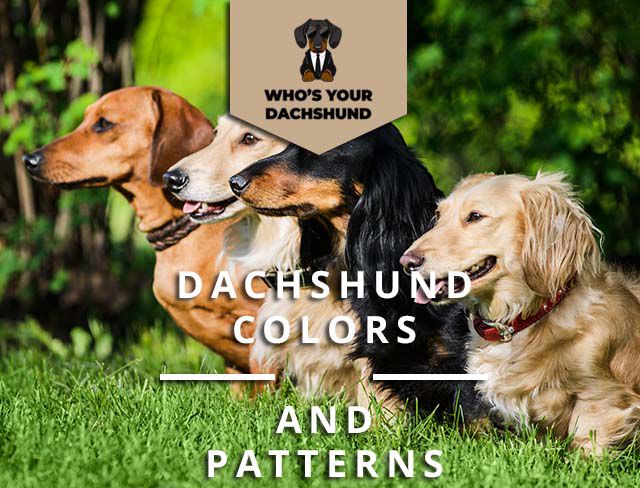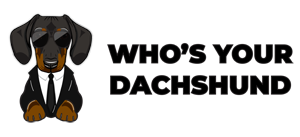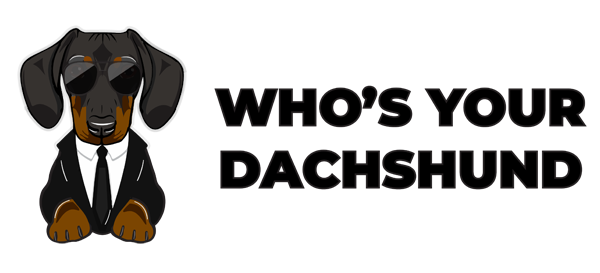
Dachshunds come in a variety of patterns and colors. Some are solid colors, like red, while others are speckled, like black and tan, or have a mask, like chocolate. You can also find dachshunds in other patterns, such as dapple (solid with large patches of another color), brindle (striped), and badger brindle (striped with a dark stripe pattern on a lighter background).
Red Colored Dachshund
Dachshunds are the best dog, the color red is one of the three most common colors for dachshunds. Red is a rich, deep, reddish color that looks almost like fire. The coat may be solid red (one color throughout) or have mahogany areas showing through on the back of the legs and underparts, usually on the stomach (underside).
Black and Tan Colored Dachshund
Dachshunds in black and tan are sometimes referred to as “tricolors.” Black and tan is a blend of black and yellow, with tan areas. The coat may be solid (one color throughout) or have mahogany areas showing through on the back of the legs and underparts, usually on the stomach (underside).
Chocolate Colored Dachshund
Dachshunds in chocolate are sometimes referred to as “tricolors.” Chocolate is a combination of black and brown, with brown patches. The coat may be solid (one color throughout) or have mahogany areas showing through on the back of the legs and underparts, usually on the stomach (underside).
Brindle Dachshund
Dachshunds in brindle are often called “tricolors” in everyday speech. Brindle is a combination of black, brown, and tan. The Dachshund’s coat is a mix of those three colors in stripes (vertical bars) with larger tan areas between them. The brindle pattern is the most common pattern for English Bulldogs.
Red Dapple Dachshund
Red dapple, or “dapple,” is a combination of red, black, and brown in a large, irregular pattern that usually outlines the dog’s body. Since there are so many variations in color and marking, these dogs have sometimes been called “Birman cats on steroids.”
Black Dapple Dachshund
Black dapple, or “dapple,” is a combination of black, brown, and tan. Because there are so many variations in color and marking, these dogs have sometimes been called “Birman cats on steroids.”
White Colored Dachshund
White dachshunds are not albino and do not lack pigment to the degree that they are not visible. They have to dilute or non-pigmented red blood cells, making them appear slightly pinkish rather than white.
Black Colored Dachshund
The color black is not an actual color but a lack of color, called “albinism.” Black dachshunds do not have any eumelanin in their coat. The black areas lack all or almost all melanin, and the body skin may also appear pinkish, where it lacks pigment. That is caused by having a gene that causes piebaldism, a condition caused when an enzyme that prevents pigment from forming is missing or defective. Albinos lack pigment to the degree that they are not visible, usually having red eyes.
Cream Colored Dachshund
The color cream is white with dilute or non-pigmented red blood cells, making them appear slightly pinkish rather than white.
Comparing Two-Colored Coat to Pattern Coat
The black and the tan coat appear to be the same shade. The black-coated dog is more likely to have white patches on the head, especially in front of the eyes. The tan coat has a few patches of white, which are more pronounced on a puppy or a young adult dog. These patches tend to fade as the dog ages, and by adulthood, they will be very minimal. The breed standard requires all dachshunds to have a black coat. However, the dog’s color is slightly more important than the coat type. Dogs with a black-and-tan coat are often called brindle and should not be bred as they tend to have health problems due to their genetic makeup. A two-colored dachshund has one or more white patches on its coat. The white patches may be minimal, but the Dachshund must have all-black coloring over most of its body. The coat’s pattern is called dapple and appears as well-defined black stripes on a background of tan. The “dapple” pattern is present in a tan coat but is more pronounced in a red coat. This type of appearance should be acceptable for the Standard Dachshund but not for the Miniature or Toy breeds.
One-Colored Dachshund
This dog has a black coat with no markings or white patches. The tan and black colors should be very dark and free of brownish highlights. There should be no red or fawn coloring on the dog’s body. This type of Dachshund is referred to as a “black.” Dachshund size is proportional to weight and not length but has been dramatically affected by breeding for show purposes.
Two-Colored Dachsunds
This color variation is also known as “tan and blacks.” Black-coated dogs can have white patches on the head, especially in front of the eyes. The tan coat has a few patches of white, which are more pronounced on a puppy or an adult dog. These patches tend to fade as the dog ages.
Dachshund Body Patterns
The Dachshund is a cute and lovable little breed. One of Dachshund’s most popular physical traits is its body shape and patterns. This article will provide information about some of the different dachshund body patterns you may see.
Standard dachshund body patterns
A typical Standard Dachshund has a long muscular body with short legs. Its body is covered with a short coat that is curly, shiny, and waterproof. The most common colors for this type of Dachshund are black/tan, chocolate/cream, red or stag red, or sometimes solid white. A red Dachshund only has a small amount of black on the nose and over the eyes.
Miniature Dachshund body patterns
The miniature Dachshund has a shorter, stouter body than the standard Dachshund. Its legs are longer than the standard Dachshund’s, and it also has a short coat and the same colors.
Wirehaired dachshund body patterns
The wirehaired Dachshund has a rough, wiry coat similar to a terrier, but it is softer than any terrier breed. It has a shorter body than the standard Dachshund. Its legs are longer than the standard Dachshund’s, and its up-tilted ears are more triangular than the dachshunds.
Rough coated dachshund body patterns
The rough-coated Dachshund is similar in body shape to a wirehaired Dachshund, but its coat is much softer and smoother. It has short coats that can be tan, red, or sable. They are also known as “Color.”
Dapple Dachshund body patterns
This type of Dachshund is solid black with splashes of white. The Dachshund’s black markings are not due to breeding but to spotting the black coat with white spots. These spots are around the eye, chest, or underbelly.
Dapple Dachshunds in Black.
The color black is not pure black, but rather more dark gray. The shade can vary from dog to dog and even on the same dog, depending on whether it has dapple markings (stripes) and the dapple amount (how many spots). A solid black usually has more dapple than a dapple with stripes. Dapple with stripes is typical of the following colors: cream, blue, red, chocolate. These dogs are born spotted and develop their color within a few months. Black Dachshunds are almost impossible to find. Although it’s a rare color to find, it’s not unheard of to see one or two black dapple dachshunds each year in the United States. Black dapple is not recognized by the AKC (American Kennel Club), nor is it recognized as a coat color for registration purposes. Although the black dapple is not a recognized color registered with the AKC (American Kennel Club), you should note that many people choose to use black dapple as a paint pattern to repaint their dogs. Therefore, it can be considered a “spotted” coat or simply an all-black coat in addition to the solid black.
Black Dapple is a unique Dachshund coat color. There are three primary coat colors – red, cream, and blue-black, and each color is spotted with different amounts of black markings. The black marking is often more prominent than the red or cream ones, giving a different look on each dog. The body and face are darker with less contrast than the red coat. This coat pattern is only found in the miniature variety of the breed. Most of them have two dapple spots on their back, but some may have as many as seven! A dog can have any combination of these spots on its body. The black color in the dapple coat pattern is black-tipped hairs. You can see this in both blue and cream-colored coats as well. Although this color was pretty widespread in the past, it is now scarce. It is unknown what causes a dog to be born with a black dapple coat pattern, but it is most common in dogs with German heritage. Dachshunds that belong to purebred lines or are bred closely together are more likely to produce puppies with this coat pattern.
What is the most common color of a Dachshund?
The most common color for a dachshund is red, though you may also find it in black, tan, or cream.
The most common color of a dachshund is red, though you may also find it in black, tan, or cream. A variety of colors are available for this breed. All colors should be equally acceptable except for blue and chocolate. The American Kennel Club does not recognize these two colors because they interfere with the dog’s ability to hunt and find prey. Dachshunds are born with a white coat (called lanugo). They are covered in hair as they grow and should have a distinct spot on the back. The Dachshund is not considered a fur coat breed. The dog’s coat should be free of mats and tangles, and the skin should not be dry or irritated by constant grooming.
What is the rarest Dachshund color?
The rarest color for a Dachshund is black. A black Dachshund has dark eyes, nose, and lips, often with a ‘smoky’ appearance. Any red-coated dog can produce a black pup if carrying the recessive ‘e’ gene. The ‘e’ gene dilutes pigment in any coat that does not carry the gene (i.e., tan, red, or white pups). So the best way to “breed out” black Dachshunds is to mate them with a dog that does not carry the ‘e’ gene.
Dachshunds with blue eyes have a recessive gene for this color. The blue gene is also known as a dilute gene, meaning that only one parent must be heterozygous (carries two different genes for the same trait) to inherit the dilution gene. It is usually apparent which of the parents carries this gene. However, both parents must have a blue pup to produce another pup with blue eyes. If one parent is red and one parent is black, then the puppies will have an even chance of having either the red or the black gene (depending on whether they get a red gene from each parent). Blue eyes are not associated with deafness (the white Dachshunds are) in Dachshunds as they are in other breeds such as Dalmatians.
Is a purebred Dachshund distinguished from a mixed-breed by its color?
If a Dachshund is red, black, tan, or cream, they are purebred.
If a Dachshund is any other color than those mentioned above, they are mixed-breed.
Dachshunds come in many different colors, and it cannot be easy to know if a dog is purebred unless they have specific markings. A dachshund’s coat can range from red, black, tan, or cream for the most part, but some have brown or gray tipping on their ears and noses.
An easy test to determine purity is the “MARKS OF PUREBRED DACHSHUND.” The majority of typical markings found on the regular Dachshund are found on each litter. Purebred dachshunds usually have:
- Large belly button
- Oval ears that hang naturally and are not round
- A large upper lip is split in the center by a slightly larger lower lip. The lips protrude more than dachshunds of mixed breeding.
- A broad, flat skull with a rounded stop
- A long, keen nose
- Wide front legs allow the dog to go over objects quickly.
- Round paws with short fur between the toes – The Dachshund’s coat should not belong and bushy like the foxhound, nor should it be short and smooth like the terrier.
- Dewclaws may or may not be present in a purebred dachshund.
- A tail that spirals over the back of the dog’s body is not extended.
- Correct coat color.
Unfortunately, some dachshunds have what is termed “weird colors” or “varsities.” These puppies are not purebred dachshunds. Although a dachshund can be matted, it does not mean it is mixed-bred and does not guarantee that later generations will be purebred.
*Dogs with any of these marks should NOT be bred.”
Can you get different colored Dachshunds?
Yes, of course. Dachshunds come in a range of different colors and patterns. You need to know that dachshunds are considered one breed because all varieties are descended from the same dogs initially bred in Germany. The most common colors are red and cream, “sausage” brown and black with tan markings. There are several different breeds in existence, including the Dachshund (giant), Dachshund (miniature), Dachshund (standard), and the Dachshund (haversack). Despite their differences, they all come in the same varieties.
Another essential thing to keep in mind is that, despite what you may have heard or seen on television or in movies, Piebald dachshunds do not exist. Piebald refers to an irregular pattern of patches of white across a solid background coloration. White dapple is that pattern plus an additional brown patch over one eye.
How many Dachshund colors can a Dachshund have?
A Dachshund is born with two colors: tan and red. Tan is the most common color among Dachshunds. Red is the darker color, and dachshunds can be born with this color by having one parent who is a red-colored dog. If both parents are red, then all of their puppies may be born with this darker color.
SUMMARY
Dachshunds can be born with various colors depending on the parents and whether they are purebred or mixed-bred. There are good colors, and there are wrong colors.
Dachshunds can be born with chocolate, blue, black, cream, red, brown, or grey coloring. These dogs may also have white-colored fur patches, but it is not accepted as a standard color variation. If you want a dachshund that has one of these other kinds of coloring, then you must specifically look for an individual who has this variation, or else you might get a dachshund that has a mottled coat pattern instead.
Dachshunds are born with a white coat called lanugo. They are covered in hair, and this hair will grow. They are born with specific spots on their backs, which will not disappear as they grow older. However, there is one exception to this rule: the parents are both purebred dachshunds. Whenever both parents belong to the same breed, all their puppies could be born with a darker coloring than a red one. This coloring is termed “recessive red,” and it is a very controversial subject.
Dachshunds are not considered a fur coat breed. As many people choose to believe, the Dachshund is also not considered hypoallergenic. Their hair can vary in length, thickness, and texture, but it does not mean you cannot be allergic to them or that they do not shed. They have normal hair and should be regularly checked with standard grooming tools such as brushes, combs, scissors, and clippers. When you groom your Dachshund, you need to take extra special care to avoid pulling their hair which could cause you to break it.
Dachshunds come in a variety of different colors and patterns. The most common colors are red and cream, “sausage” brown and black with tan markings. There are several different breeds in existence, including the Dachshund (giant), Dachshund (miniature), Dachshund (standard), and the Dachshund (haversack). Despite their differences, they all come in the same varieties.

